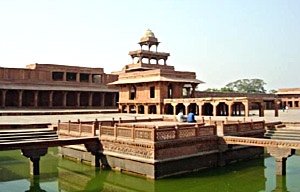 Fatehpur Sikri was built by Mughal emperor Akbar to commemorate the victory of Babur against Rana Sanga. Built in red sandstone this monument stands tall in the Indian state of Uttar Pradesh. The sculpture of Fatehpur Sikri is in accordance with the idiom followed by the Mughals for building forts.
Fatehpur Sikri was built by Mughal emperor Akbar to commemorate the victory of Babur against Rana Sanga. Built in red sandstone this monument stands tall in the Indian state of Uttar Pradesh. The sculpture of Fatehpur Sikri is in accordance with the idiom followed by the Mughals for building forts.
One of the key features of the architecture of Fatehpur Sikri is that almost all the architectural elements of the Mughals have been included within this fort. The other sculptural delights within Fatehpur Sikri comprise of the following:
| Sculpture of Naubat Khana | Sculpture of Diwan-i-Khas | Sculpture of Char Chaman Tank | Sculpture of Ajmer e Sharif |
| Sculpture of Jodhabai Palace | Sculpture of Mariam-uz-Zamani Palace | Sculpture of Panch Mahal | Sculpture of Jama Masjid |
| Sculpture of Diwan-i-Aam | Sculpture of Pachisi Court | Sculpture of Buland Darwaza |



















